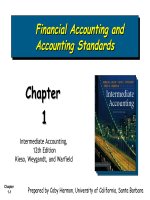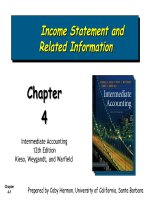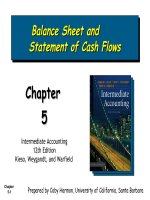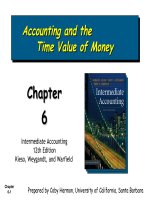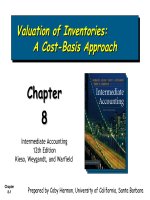Intermediate accounting 12th edition kieso warfield chapter 11
Bạn đang xem bản rút gọn của tài liệu. Xem và tải ngay bản đầy đủ của tài liệu tại đây (332.14 KB, 38 trang )
Depreciation,
Depreciation, Impairments,
Impairments,
and
and Depletion
Depletion
Chapter
11
Intermediate Accounting
12th Edition
Kieso, Weygandt, and Warfield
Chapter
11-1
Prepared by Coby Harmon, University of California, Santa Barbara
Learning
Learning Objectives
Objectives
1.
Explain the concept of depreciation.
2.
Identify the factors involved in the depreciation process.
3.
Compare activity, straight-line, and decreasing-charge
methods of depreciation.
4.
Explain special depreciation methods.
5.
Explain the accounting issues related to asset impairment.
6.
Explain the accounting procedures for depletion of natural
resources.
7.
Explain how to report and analyze property, plant,
equipment, and natural resources.
Chapter
11-2
Depreciation,
Depreciation, Impairments,
Impairments, and
and Depletion
Depletion
Depreciation
Impairments
Factors involved
Methods of
depreciation
Special methods
Recognizing
impairments
Measuring
Impairments
Restoration of
loss
Assets to be
disposed of
Special issues
Chapter
11-3
Depletion
Establishing a
base
Write-off of
resource cost
Continuing
controversy
Special problems
Presentation
and Analysis
Presentation
Analysis
Depreciation
Depreciation -- Method
Method of
of Cost
Cost Allocation
Allocation
Depreciation is the accounting process of allocating
the cost of tangible assets to expense in a systematic
and rational manner to those periods expected to
benefit from the use of the asset.
Allocating costs of long-term assets:
Fixed assets = Depreciation expense
Intangibles = Amortization expense
Natural resources = Depletion expense
Chapter
11-4
LO 1 Explain the concept of depreciation.
Depreciation
Depreciation -- Method
Method of
of Cost
Cost Allocation
Allocation
Factors Involved in the Depreciation Process
Three basic questions:
(1) What depreciable base is to be used?
(2) What is the asset’s useful life?
(3) What method of cost allocation is best?
Chapter
11-5
LO 2 Identify the factors involved in the depreciation process.
Depreciation
Depreciation -- Method
Method of
of Cost
Cost Allocation
Allocation
Methods of Depreciation
The profession requires the method employed be
“systematic and rational.” Examples include:
(1)
Activity method (units of use or production).
(2) Straight-line method.
(3) Sum-of-the-years’-digits.
(4) Declining-balance method.
(5) Group and composite methods.
(6) Hybrid or combination methods.
Chapter
11-6
Accelerated methods
Special methods
LO 3 Compare activity, straight-line, and decreasingcharge methods of depreciation.
Depreciation
Depreciation -- Method
Method of
of Cost
Cost Allocation
Allocation
Exercise (Depreciation Computations—Four Methods) Robert
Parish Corporation purchased a new machine for its assembly
process on September 30, 2007. The cost of this machine was
$117,900. The company estimated that the machine would have a
salvage value of $12,900 at the end of its service life. Its life is
estimated at 5 years and its working hours are estimated at 1,000
hours. Year-end is December 31.
Instructions: Compute the depreciation expense under the
following methods.
(a) Straight-line depreciation.
(b) Activity method.
(c) Sum-of-the-years’-digits.
(d) Double-declining balance.
Chapter
11-7
LO 3 Compare activity, straight-line, and decreasingcharge methods of depreciation.
Depreciation
Depreciation -- Method
Method of
of Cost
Cost Allocation
Allocation
Exercise (Straight-line Method)
Year
2007
Depreciable
Base
$ 105,000
/
2008
2009
2010
2011
2012
105,000
105,000
105,000
105,000
105,000
/
/
/
/
/
Years
5
=
5
5
5
5
5
=
=
=
=
=
Annual
Expense
$ 21,000
21,000
21,000
21,000
21,000
21,000
x
x
Partial
Year
3/12
9/12
=
=
Current
Year
Expense
$
5,250
21,000
21,000
21,000
21,000
15,750
$ 105,000
Accum.
Deprec.
$ 5,250
26,250
47,250
68,250
89,250
105,000
Journal entry:
2007
Depreciation expense
5,250
Accumultated depreciation
Chapter
11-8
5,250
LO 3 Compare activity, straight-line, and decreasingcharge methods of depreciation.
Depreciation
Depreciation -- Method
Method of
of Cost
Cost Allocation
Allocation
Exercise (Activity Method)
($105,000 / 1,000 hours = $105 per hour)
Year
2007
(Given)
Hours
Used
200
2008
2009
150
250
x
x
105
105
=
=
15,750
26,250
15,750
26,250
36,750
63,000
2010
300
x
105
=
31,500
31,500
94,500
2011
100
1,000
x
105
=
10,500
10,500
$ 105,000
105,000
Rate per
Hours
x $105 =
Annual
Expense
$ 21,000
Journal entry:
2007
Depreciation expense
Accum.
Deprec.
$ 21,000
21,000
Accumultated depreciation
Chapter
11-9
Partial
Year
Current
Year
Expense
$ 21,000
21,000
LO 3 Compare activity, straight-line, and decreasingcharge methods of depreciation.
Depreciation
Depreciation -- Method
Method of
of Cost
Cost Allocation
Allocation
Exercise (Sum-of-the-years’-digits Method)
Year
2007
2008
Depreciable
Base
$ 105,000
105,000
2009
Accum.
Deprec.
$ 8,750
42,000
x
x
Years
5/15
=
4.75/15 =
Annual
Expense
$ 35,000
33,250
105,000
x
3.75/15 =
26,250
26,250
68,250
2010
2011
105,000
105,000
x
x
2.75/15 =
1.75/15 =
19,250
12,250
19,250
12,250
87,500
99,750
2012
105,000
x
5,250
5,250
$ 105,000
105,000
.75/15
=
x
Partial
Year
3/12
Current
Year
Expense
$
8,750
33,250
Journal entry:
2007
Depreciation expense
8,750
Accumultated depreciation
Chapter
11-10
8,750
LO 3 Compare activity, straight-line, and decreasingcharge methods of depreciation.
Depreciation
Depreciation -- Method
Method of
of Cost
Cost Allocation
Allocation
Exercise (Double-Declining Balance Method)
Year
2007
2008
2009
2010
2011
2012
Depreciable
Base
$ 117,900
106,110
63,666
38,200
22,920
13,752
x
x
x
x
x
x
Rate
per Year
40%
40%
40%
40%
40%
40%
=
=
=
=
=
=
Annual
Expense
$ 47,160 x
42,444
25,466
15,280
9,168
5,501
Partial
Year
3/12
Plug
Current
Year
Expense
= $ 11,790
42,444
25,466
15,280
9,168
852
$ 105,000
Accum.
Deprec.
$ 11,790
54,234
79,700
94,980
104,148
105,000
Journal entry:
2007
Depreciation expense
11,790
Accumultated depreciation
Chapter
11-11
11,790
LO 3 Compare activity, straight-line, and decreasingcharge methods of depreciation.
Depreciation
Depreciation -- Method
Method of
of Cost
Cost Allocation
Allocation
Special Depreciation Methods
The choice of method depends on the nature of the
assets involved:
Group method used when the assets are similar in
nature and have approximately the same useful lives.
Composite approach used when the assets are dissimilar
and have different lives.
Companies are also free to develop tailor-made
depreciation methods, provided the method results in
the allocation of an asset’s cost in a systematic and
rational manner (Hybrid or Combination Methods).
Chapter
11-12
LO 4 Explain special depreciation methods.
Depreciation
Depreciation -- Method
Method of
of Cost
Cost Allocation
Allocation
Special Depreciation Issues
(1) How should companies compute depreciation for
partial periods?
Companies normally compute depreciation on the
basis of the nearest full month.
(1) Does depreciation provide for the replacement of
assets?
Funds for the replacement of the assets come from
the revenues
(1) How should companies handle revisions in
depreciation rates?
Chapter
11-13
LO 4 Explain special depreciation methods.
Depreciation
Depreciation -- Method
Method of
of Cost
Cost Allocation
Allocation
Changes in Depreciation Rate
Accounted for in the period of change and
future periods (Change in Estimate)
Not handled retrospectively
Not considered errors or extraordinary items
Chapter
11-14
LO 4 Explain special depreciation methods.
Change
Change in
in Estimate
Estimate Example
Example
Arcadia HS, purchased equipment for $510,000 which
was estimated to have a useful life of 10 years with a
salvage value of $10,000 at the end of that time.
Depreciation has been recorded for 7 years on a
straight-line basis. In 2005 (year 8), it is determined
that the total estimated life should be 15 years with a
salvage value of $5,000 at the end of that time.
Questions:
What is the journal entry to correct
the prior years’ depreciation?
Calculate the depreciation expense
for 2005.
Chapter
11-15
No Entry
Required
LO 4 Explain special depreciation methods.
Change
Change in
in Estimate
Estimate Example
Example
After 7 years
Equipment cost
First,
establish
First,
establish
$510,000
NBV
NBV at
atdate
dateof
of
Salvage value
change
changein
inestimate.
estimate.
- 10,000
Depreciable base
x 7 years = $350,000
500,000
Useful life (original)
Balance Sheet (Dec. 31, 2004)
10 years
Fixed Assets:
Annual depreciation
$ 50,000 Equipment
$510,000
Accumulated depreciation
350,000
Net book value (NBV)
Chapter
11-16
$160,000
LO 4 Explain special depreciation methods.
Change
Change in
in Estimate
Estimate Example
Example
After 7 years
Net book value
Depreciation
Depreciation
$160,000
Expense
Expensecalculation
calculation
for
Salvage value (new)
for2005.
2005.
5,000
Depreciable base
155,000
Useful life remaining
8Journal
years entry for 2005
Annual depreciation
Depreciation expense
19,375
$ 19,375
Accumulated depreciation
19,375
Chapter
11-17
LO 4 Explain special depreciation methods.
Impairments
Impairments
When the carrying amount of an asset is not
recoverable, a company records a write-off referred
to as an impairment.
Events leading to an impairment:
a.
Decrease in the market value of an asset.
b. Change in the manner in which an asset is used.
c.
Adverse change in legal factors or in the business climate.
d. An accumulation of costs in excess of the amount originally
expected to acquire or construct an asset.
e.
Chapter
11-18
A projection or forecast that demonstrates continuing losses
associated with an asset.
LO 5 Explain the accounting issues related to asset impairment.
Impairments
Impairments
Measuring Impairments
1. Review events for possible impairment.
2. If the review indicates impairment, apply the
recoverability test. If the sum of the expected future
net cash flows from the long-lived asset is less than the
carrying amount of the asset, an impairment has
occurred.
3. Assuming an impairment, the impairment loss is the
amount by which the carrying amount of the asset
exceeds the fair value of the asset. The fair value is
the market value or the present value of expected
future net cash flows.
Chapter
11-19
LO 5 Explain the accounting issues related to asset impairment.
Impairments
Impairments
Illustration 11-16
Accounting for
Impairments
Chapter
11-20
LO 5 Explain the accounting issues related to asset impairment.
Impairments
Impairments
E11-16 (Impairment) Presented below is information related to
equipment owned by Suarez Company at December 31, 2007.
Assume that Suarez will continue to use this asset in the future.
As of December 31, 2007, the equipment has a remaining useful
life of 4 years.
Instructions:
Cost
Accumulated depreciation to date
Expected future net cash flows
Fair value
$
9,000,000
1,000,000
7,000,000
4,800,000
(a) Prepare the journal entry (if any) to record the impairment of the
asset at December 31, 2007.
(b) Prepare the journal entry to record depreciation expense for 2008.
(c) The fair value of the equipment at December 31, 2008, is $5,100,000.
Prepare the journal entry (if any) necessary to record this increase in
fair value.
Chapter
11-21
LO 5 Explain the accounting issues related to asset impairment.
Impairments
Impairments
(a).
Cost
$9,000,000
Accumulated depreciation
1,000,000
Carrying amount
8,000,000
Fair value
4,800,000
Loss on impairment
$3,200,000
12/31/07
Loss on impairment
3,200,000
Accumulated depreciation
3,200,000
Chapter
11-22
LO 5 Explain the accounting issues related to asset impairment.
Impairments
Impairments
(b).
Net carrying amount
Useful life
Depreciation per year
$4,800,000
4 years
$1,200,000
12/31/08
Depreciation expense
1,200,000
Accumulated depreciation
1,200,000
(c). Restoration of any impairment loss is not permitted.
Chapter
11-23
LO 5 Explain the accounting issues related to asset impairment.
Depletion
Depletion
Natural resources, often called wasting assets,
include petroleum, minerals, and timber.
They have two main features:
1. complete removal (consumption) of the asset, and
2. replacement of the asset only by an act of nature.
Depletion is the process of allocating the cost of
natural resources.
Chapter
11-24
LO 6 Explain the accounting procedures for depletion of natural resources.
Depletion
Depletion
Establishing a Depletion Base
Computation of the depletion base involves four factors:
(1) Acquisition cost of the deposit,
(2) Exploration costs,
(3) Development costs, and
(4) Restoration costs.
Chapter
11-25
LO 6 Explain the accounting procedures for depletion of natural resources.


